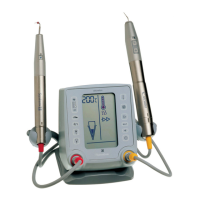5
Other problem areas to check:
• Ensure the le barely goes through the terminus. A loose le will
give inaccurate readings.
• If the apex is larger than .40mm there might not be ample
constricture for accurate readings.
• Bone or periodontal ligament loss (indicated by a radiolucency on
the lm) can cause inaccurate readings.
• If baery power is low, plug the unit into a wall outlet
• File or probe contact with a metal restoraon will ground the
circuit and inaccurately indicate the apex.
• If the canal is too dry, introduce NaOCl to the apical 1/2 of the canal.
VitalityScanner(VS)ModeInstrucons
NumericDisplay
Vitality response values range from 1 to 80. When the maximum value
of 80 is reached, your Numeric Display ashes unl contact is broken.
GraphicDisplay
When a circuit is completed, a small horizontal bar will appear
under the Numeric Display unl the circuit is broken. A vercal bar
corresponds to the numeric response value.
Satellite Display
The Satellite Display mimics your Graphic Display. The top LED segment
indicates a completed circuit.
VitalityScannerDireconsforUse
1. Grasping the Satellite Cord plug by its knurled secon, line up the
red dots and gently push it into its receptacle at the front of the
unit. The cord may only be plugged in or removed by pulling the
knurled secon of the plug.
2. Place the Paent Lead Cord connector into the Satellite Cord
receptacle.
3. Insert either the Standard or the Mini Crown Test Probe into the
Paent Lead Cord receptacle.
4. Power the unit by depressing the buon.
5. Ensure the unit reads “vitality” in the upper right hand corner
conrming the unit is in Vitality Scanner mode. If not, press the
buon to do so.
6. Adjust the rate of smulus increase with the panel keys. This rate
can be re-adjusted during tesng.
7. Place the lip clip on the paent’s lip. Direct contact between the
mucosa and the lip clip must be made for proper funcon.
8. Dry the tooth to be tested.
9. Dip the probe p into a small amount of gel toothpaste or topical
anesthec and place it on the tooth. Do not contact the gingiva.
10. Upon contact, a small horizontal bar appears under the numerical
display and remains unl contact is broken.
11. Maintain contact with the tooth unl your paent perceives
a pulsang pressure, warmth, or ngling. A chart on normal
responses follows this secon.
12. If contact is broken and re-established within 1 second, tesng
connues without reseng. This feature avoids accidental reseng
if momentary loss of contact occurs. The unit resets aer 1 second
of lost contact to aid rapid tesng of mulple teeth.
Test Response
Normal test response ranges for vital teeth are:
Incisors 10-40
Bicuspids 20-50
Molars 30-70
These are not absolutes and will vary from paent to paent.
VitalityScannerUsageNotesandHints
• The unit automacally acvates upon contact between probe and
tooth. This ensures the paent inially receives the lowest output.
• Begin tesng on teeth adjacent to the subject tooth to provide a
comparave basis.
• The Mini Crown Probe allows access below the margin of a
porcelain crown.
• Lower resistance of metallic llings produce readings considerably
lower than natural tooth material.
VitalityScannerTroubleshoong
A false negave occurs when a vital tooth does not respond to the
maximum level of 80.
Causes include:
• Moisture on the surface of the tooth. False negaves can oen be
avoided by drying the tested tooth
• Ametallic lling contacng periodontal ssue.
• Severe calcicaon of pulpal ssue.
• Immature apices.
• Severe trauma to the tooth.
• Other condions resulng in degradaon of neural response.
A false posive occurs when your paent perceives the smulus on a
necroc tooth.
Causes include:
• A paent sensing smulaon in an adjacent tooth in contact with
the subject tooth.
• A paent sensing a periodontal neural smulus instead of a pulpal
nerve smulus. The periodontal response is quite dierent than
a pulpal response. Compare the sensaon perceived on a tooth
being vitality tested with the direct smulaon of periodontal
ssue prior to vitality tesng.
ExpectedLifeofAccessories
All accessories are reusable for a limited number of procedures.
This number is highly dependent on how and for what duraon the
instrument is used and, therefore, will vary signicantly from user to
user. If the device funcon appears errac, an accessory may have
exceeded its useful life and should be replaced.
Cleaning,Sterilizaon,andMaintenance
Cleaning
The Unit and Satellite should be wiped twice with CaviWipes or a clean
cloth moistened with Cavicide(Metrex714-516-7400) for cleaning and
disinfecng. The rst wipe will clean the instrument, the second wipe
will disinfect. Do not submerge the device or allow liquid to enter the
enclosure. DonotAutoclavetheunitorsatellite.
Sterilizaon
Probes, File Clips, and the Paent Lead Cord must be cleaned, sterilized,
and inspected before every use:
1. Clean with CaviWipes or a clean cloth moistened with Cavicide or
warm water. Dry thoroughly.
2. Double wrap the Probes, Clips, and Lead Cords using a typical central
service wrapping technique and place into autoclave unit avoiding
contact with other instruments.
3. Operate sterilizaon cycle at 250°F (121°C) for 30 minutes or 270°F
(132°C) for 25 minutes. Follow the instrucons supplied with your
autoclave unit for specic operang instrucons.
TechnicalSpecicaons
Dimensions
Weight Main Unit Satellite Unit
Main Unit: 0.9 kg Height 42 mm Height 17 mm
Satellite Unit: 0.05 kg Width 96 mm Width 54 mm
Depth 107 mm Depth 65 mm
Classicaon: IEC 601-1 Class 2, Paent Contact
Mode of Operaon: IEC 601-1 Connuous Operaon
Degree of safety of applicaon in presence of a ammable anesthec
mixture: Unit unsuitable for use in presence of a ammable anesthec
mixture with air or with oxygen or nitrous oxide.

